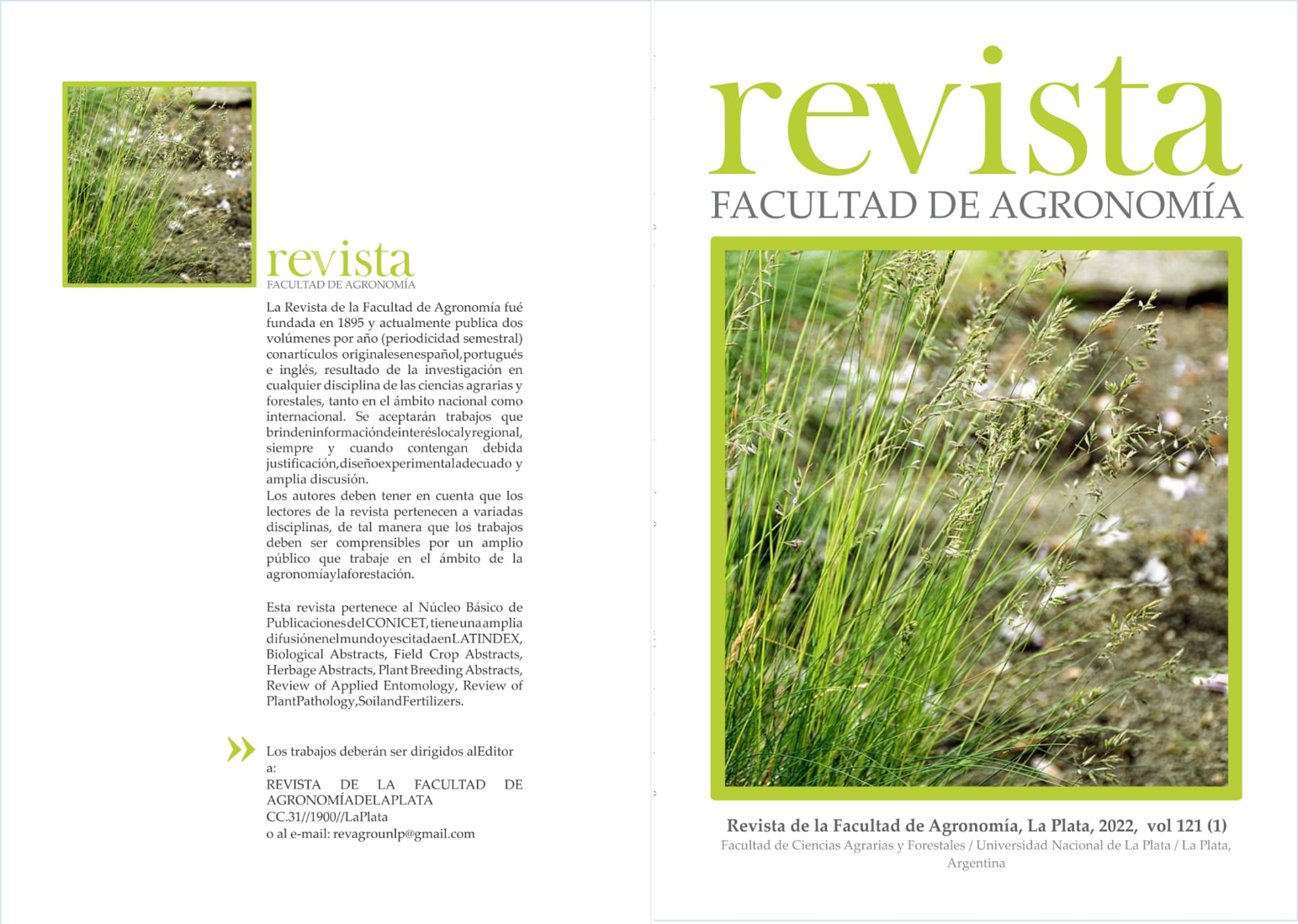Utilización de álamos y sauces para la producción de biomasa para energía
DOI:
https://doi.org/10.24215/16699513e091Palabras clave:
álamos, sauces, biocombustibles, biomasa leñosaResumen
En esta revisión, se describen las principales características del uso de Salicáceas (álamos y sauces) en plantaciones de rotación corta para producir biomasa para energía. Se analizan distintos tipos de plantaciones para producir biomasa y la sustentabilidad de las mismas. Se resumen los resultados del mejoramiento de sauces y álamos para producir biomasa en distintos países. Finalmente, se discuten aspectos que será necesario investigar para el desarrollo de plantaciones de rotación corta con Salicáceas para producir biomasa en Argentina.
Descargas
Referencias
Abrahamsom L.P.; T.A. Volk; L.B. Smart & K. D. Cameron. (2010). Shrub Willow Biomass Producer's Handbook. State University of New York, College of Environmental Science and Forestry. Disponible en: https://www.esf.edu › willow › ProducersHandbook.
Achinelli, F.G. (2007). Bases para el desarrollo de un sistema integrado de control de malezas en el establecimiento de plantaciones de Populus spp. del centro-norte de la provincia de Buenos Aires, Argentina. Tesis de maestría. Facultad de Ciencias Agrarias y Forestales. UNLP. 196 pp. Disponible en: http://sedici.unlp.edu.ar/handle/10915/1818. Último acceso: febrero 2022.
Achinelli, F.G.; G.N. Doffo; A.J. Barotto; V.M.C. Luquez & S.E. Monteoliva. (2018). Effects of irrigation, plantation density and genotype on woody biomass quality for bioenergy in a short rotation culture system with willows (Salix spp.). Revista Árvore 42(2): e420210.
Agostini F.; A.S. Gregory & G. M. Richter. (2015). Carbon Sequestration by Perennial Energy Crops: Is the Jury Still Out? Bioenergy Research 8:1057–1080.
Albertsson J.; T. Verwijst; D. Hansson; N-O. Bertholdsson & I. Åhman. (2014). Effects of competition between short-rotation willow and weeds on performance of different clones and associated weed flora during the first harvest cycle. Biomass and Bioenergy 70: 364-372.
Almeida, P.; E. Proux-Wera; A. Churcher; L. Soler; J. Dainat; P. Pucholt; J. Nordlund; T. Martin; A.C. Rönnberg-Wästljung; B. Nystedt; S. Berlin & J.E. Manket. (2020). Genome assembly of the basket willow, Salix viminalis, reveals earliest stages of sex chromosome expansion. BMC Biology 18:78.
Alvarez, J. (2018). Estabilidad productiva y plasticidad fenotípica de Populus spp. en relación con el contenido de agua y sales en el suelo en el Delta del Paraná, Argentina. Tesis doctoral. Facultad de Agronomía. Universidad de Buenos Aires. 149 pp. Disponible en: http://ri.agro.uba.ar/cgi-bin/library.cgi?a=d&c=tesis&d=2018alvarezjavieralejandro. Último acceso: julio 2021.
Baettig, R.; M. Yáñez & M. Albornoz. (2010). Cultivos dendroenergéticos de híbridos de álamo para la obtención de biocombustibles en Chile: estado del arte. Bosque 31(2): 89-99.
Bergante, S.; G. Facciotto & G. Minotta. (2010). Identification of the main site factors and management intensity affecting the establishment of Short Rotation Coppice (SRC) in Northern Italy through stepwise regression analysis. Central European Journal of Biology 5(4): 522–530.
Berhongaray, G.; M.S. Verlinden; L.S. Broeckx & R. Ceulemans. (2015). Changes in belowground biomass after coppice in two Populus genotypes. Forest Ecology and Management 337: 1–10.
Berhongaray, G.; F.M. Cotrufo; I.A. Janssens & R. Ceulemans. (2019). Below-ground carbon inputs contribute more than above-ground inputs to soil carbon accrual in a bioenergy poplar plantation. Plant and Soil 434: 363–378.
Berlin, S.; L. Ghelardini; L. Bonosi; M. Weih & A.C. Rönnberg-Wastljung. (2014). QTL mapping of biomass and nitrogen economy traits in willows (Salix spp.) grown under contrasting water and nutrient conditions. Mol Breeding 34:1987–2003.
Berlin, S.; H.R. Hallingback; F. Beyer; N.E. Nordh; M. Weih & A.C. Ronnberg-Wastljung. (2017). Genetics of phenotypic plasticity and biomass traits in hybrid willows across contrasting environments and years. Annals of Botany 120: 87–100.
Berthod, N.; N.J.B. Brereton; F.E. Pitre & M. Labrecque. (2015). Five willow varieties cultivated across diverse field environments reveal stem density variation associated with high tension wood abundance. Frontiers in Plant Sciences 6: 948.
Borodowski, E.D. (2017). Situación actual del cultivo y uso de las Salicáceas en Argentina. V Congreso Internacional de Salicáceas. 20 pp. Disponible en: https://drive.google.com/file/d/1eNX9a0bgeIHb5puAJfO0fdGo7XuSt4n1/view. Ultimo acceso: agosto 2020.
Böhlenius, H. & R. Övergaard. (2015). Growth response of hybrid poplars to different types and levels of vegetation control. Scandinavian Journal of Forest Research 30(6): 516-525.
Brereton, N.J.B.; F.E. Pitre; I. Shield; S.J. Hanley; M.J. Ray; R.J. Murphy & A. Karp. (2014). Insights into nitrogen allocation and recycling from nitrogen elemental analysis and 15N isotope labelling in 14 genotypes of willow. Tree Physiology 34: 1252–1262.
Buchman, D.; J. Jackson; W.E. Berguson; B.G. McMahon; N.D. Nelson; J. DuPlissis & G.E. Host. (2020). Grower's Guide for Hybrid Poplar Plantations for Biomass Production. University of Minnesota Extension Report Number: NRRI/TR-2020/15. 15 pp. Disponible en: https://conservancy.umn.edu/handle/11299/213759. Ultimo acceso: agosto 2020.
Bustamante, J.; D. Funes; M. Clausen & M. Barbeito. (2011). Populus x canadensis Conti 12 como fuente de energía. Tercer Congreso Internacional de Salicáceas en Argentina. 6 pp. Disponible en: http://jornadasdesalicaceas2011.blogspot.com/p/trabajos-tecnicos.html. Ultimo acceso: agosto 2020.
Cerrillo, T.; S. Loval; J. Grande; I. Fosco; J.M. Garcia Conde; R. Austin; M. García Cortés; C. Fuentes & M. Jouanny. (2020). Selección de sauces arbóreos para aplicación en cultivos de corta rotación. XXXIV Jornadas Forestales de Entre Ríos. Octubre. Concordia, Argentina. Disponible en: https://www.jornadasforestales.com.ar/book/2020.html. Último acceso: Julio 2021.
Chanoca, A.; L. de Vries & W. Boerjan. (2019). Lignin Engineering in Forest Trees. Frontiers in Plant Science 10: 912.
Christian, D.P.; G.J. Niemi; J.M. Hanowski & P. Collins. (1994). Perspectives on biomass energy tree plantations and changes in habitat for biological organisms. Biomass and Bioenergy 6: 31-39.
Clifton-Brown J.; A. Harfouche; M.D. Casler; H. Dylan Jones; W.J. Macalpine; D. Murphy-Bokern; L.B. Smart; A. Adler; C. Ashman; D. Awty-Carroll; C. Bastien; S. Bopper; V. Botnari; M. Brancourt-Hulmel; Z. Chen; L.V. Clark; S. Cosentino; S. Dalton; C. Davey; … I. Lewandowski. (2019). Breeding progress and preparedness for mass‐scale deployment of perennial lignocellulosic biomass crops switchgrass, miscanthus, willow and poplar. GCB Bioenergy 11: 118-151.
Dimitriou, I. & B. Mola-Yudego. (2017). Impact of Populus Plantations on Water and Soil Quality. Bioenergy Research 10: 750–759.
Doffo G.; F. Achinelli; M.E. Rodríguez & V.M.C. Luquez. (2017a). Rendimiento de un sistema de rotación corta de alta densidad con Salix spp. en Buenos Aires, Argentina. Bosque 38(3): 587-592.
Doffo, G.; S. Monteoliva; M.E. Rodríguez & V.M.C. Luquez. (2017b). Physiological responses to alternative flooding and drought stress episodes in two willows (Salix spp.) clones. Canadian Journal of Forest Research 47: 174-182.
Du Q.; C. Gong; Q. Wang; D. Zhou; H. Yang; W. Pan; B. Li & D. Zhang. (2016). Genetic architecture of growth traits in Populus revealed by integrated quantitative trait locus (QTL) analysis and association studies. New Phytologist 209: 1067-1082.
Eisenbies M.H.; T.A. Volk; J. Espinoza; C. Gantz, A. Himes; J. Posselius; R. Shuren; B. Stanton & Bruce Summers. (2017). Biomass, spacing and planting design influence cut-and-chip harvesting in hybrid poplar. Biomass and Bioenergy 106: 182-190.
Fabio, E.S & L.B. Smart. (2018). Differential growth response to fertilization of ten elite shrub willow (Salix spp.) bioenergy cultivars. Trees 32: 1061-1072.
FAO. (2020). Potencial de desarrollo de plantaciones dendroenergéticas en la Argentina. Colección Documentos Técnicos N°18. Buenos Aires, Argentina. 94 pp. Disponible en: https://doi..org/10.4060/ca8031es. Último acceso: agosto 2020.
Fichot, R.; F. Laurans; R. Monclus; A. Moreau; G. Pilate & F. Brignolas. (2009). Xylem anatomy correlates with gas exchange, water-use efficiency and growth performance under contrasting water regimes: evidence from Populus deltoides x Populus nigra hybrids. Tree Physiology 29: 1537-1549.
Forbes, E.; C. Johnston; J. Archer & A. McCracken. (2017). SRC willow as a bioremediation medium for a dairy farm effluent with high pollution potential. Biomass and Bioenergy 105: 174-189.
Fortier, J.; B. Truax; D. Gagnon & F. Lambert. (2017). Linking Biomass Productivity to Genotype-Specific Nutrient Cycling Strategies in Mature Hybrid Poplars Planted Along an Environmental Gradient. Bioenergy Research 10: 876-890.
Fritsche, S.; A.L. Klocko; A. Boron; A.M. Brunner & G. Thorlby. (2018). Strategies for Engineering Reproductive Sterility in Plantation Forests. Frontiers in Plant Science 9: 1671.
Ghelardini, L.; S. Berlin; M. Weih; U. Lagercrantz; N. Gyllenstrand & A.C. Rönnberg-Wästljung. (2014). Genetic architecture of spring and autumn phenology in Salix. BMC Plant Biology 14: 31.
Gregory A.S.; J.A.J. Dungait; I.F. Shield; W.J. Macalpine; J. Cunniff; M. Durenkamp; R.P. White; A. Joynes & G.M. Richter. (2018). Species and Genotype Effects of Bioenergy Crops on Root Production, Carbon and Nitrogen in Temperate Agricultural Soil. BioEnergy Research 11: 382-397.
Guarnaschelli A.B.; A.M. Garau; S.C. Cortizo; J. Alvarez & J.H. Lemcoff (2011). Respuestas diferenciales a la sequía en clones de Populus deltoides cultivados en el Delta del Paraná. Tercer Congreso Internacional de Salicáceas en Argentina, “Los álamos y los sauces junto al paisaje y el desarrollo productivo de la Patagonia”. Jornada de Salicaceas, 16-19 de Marzo. Neuquén, Argentina. Disponible en: http://jornadasdesalicaceas2011.blogspot.com/p/trabajos-tecnicos.html. Último acceso: julio 2021.
Han Q.; H. Harayama; A. Uemura; E. Ito; H. Utsugi; M. Kitao & Y. Maruyama. (2020). High biomass productivity of Short-Rotation willow plantation in boreal Hokkaido achieved by mulching and cutback. Forests 11: 505.
Hanley, S.J. & A. Karp. (2014). Genetic strategies for dissecting complex traits in biomass willows (Salix spp.). Tree Physiology 34: 1167-1180.
Intergovernmental panel on climate change. IPCC. (2014). Climate change 2014 Synthesis Report. 169 pp. Disponible en: https://archive.ipcc.ch/report/ar5/syr/. Último acceso: agosto 2020.
Jorge, V.; A. Dowkiw; P. Faivre-Rampant & C. Bastien. (2005). Genetic architecture of qualitative and quantitative Melampsora larici-populina leaf rust resistance in hybrid poplar: genetic mapping and QTL detection. New Phytologist 167: 113-127.
Karp, A. & I. Shield. (2008). Bioenergy from plants and the sustainable yield challenge. New Phytologist 179: 15-32.
Karp, A.; S.J. Hanley; S.O. Trybush; W. Macalpine; M. Pei & I. Shield. (2011). Genetic Improvement of Willow for Bioenergy and Biofuels. Journal of Integrative Plant Biology 53(2): 151-165.
Keoleian, G.A. & T.A. Volk. (2005). Renewable Energy from Willow Biomass Crops: Life Cycle Energy, Environmental and Economic Performance. Critical Reviews in Plant Sciences 24: 385-406.
Krzyżaniak, M.; M.J. Stolarski; S. Szczukowski & J. Tworkowski. (2016). Life Cycle Assessment of New Willow Cultivars Grown as Feedstock for Integrated Biorefineries. Bioenergy Research 9: 224-238.
Kulig, B.; E. Gacek; R. Wojciechowski; A. Oleksy; M. Kołodziejczyk; W. Szewczyk & A. Klimek-Kopyra. (2019). Biomass yield and energy efficiency of willow depending on cultivar, harvesting frequency and planting density. Plant, Soil and Environment 65.
Kuzovkina, Y. & T.A. Volk. (2009). The characterization of willow (Salix L.) varieties for use in ecological engineering applications: coordination of structure, function and autoecology. Ecological Engineering 35: 1178-1189.
Liu, N.; S. Larsen; U. Jorgensen; D. Murach; C. Pflugmacher; H. Hartmann & P.E. Laerke. (2017). Combustion quality of poplar and willow clones grown as SRC in four sites in Brandenburg, Germany. Biomass and Bioenergy 106: 51-62.
Luke Williams, C.; T.L. Westover; R.M. Emerson; J.S. Tumuluru & C. Li. (2016). Sources of Biomass Feedstock Variability and the Potential Impact on Biofuels Production. Bioenergy Research 9: 1-14.
Luquez, V.M.C.; F. Achinelli & S. Cortizo. (2012). Evaluation of flooding tolerance in cuttings of Populus clones used for forestation at the Paraná River Delta, Argentina. Southern Forests 74: 61-70.
Luquez, V.M.C; T. Cerrillo & M.E. Rodríguez. (2018). Tolerancia a la inundación en sauces plantados en la Argentina: conocimiento actual y perspectivas. Revista de la Facultad de Agronomía 117(1): 89-98.
Meiresonne, L.; A. De Schrijver & B. De Vos. (2007). Nutrient cycling in a poplar plantation (Populus trichocarpa x Populus deltoides ‘Beaupré’) on former agricultural land in northern Belgium. Canadian Journal of Forest Research 37: 141-155.
Mosseler, A.; J.E. Major & M. Labrecque. (2014). Genetic by environment interactions of two North American Salix species assessed for coppice yield and components of growth on three sites of varying quality. Trees 28: 1401-141.
Naidoo, S.; B. Slippers; J.M. Plett; D. Coles & C.N. Oates. (2019). The Road to Resistance in Forest Trees. Frontiers in Plant Science 10: 273.
Nelson, N.D.; R. Meilan; W.E. Berguson; B.G. McMahon; M. Cai & D. Buchman. (2019). Growth performance of hybrid poplar clones on two agricultural sites with and without early irrigation and fertilization. Silvae Genetica 68: 58-66.
Niemczyk, M. (2021). The effects of cultivar and rotation length (5 vs. 10 years) on biomass production and sustainability of poplar (Populus spp.) bioenergy plantation. GCB-Bioenergy 13(6): 999-1014.
Niemczyk, M.; Y. Hu & B.R. Thomas. (2019). Selection of Poplar Genotypes for Adapting to Climate Change. Forest 10: 1041.
Nissim, W.G.; F.E. Pitre; T.I. Teodorescu & M. Labrecque. (2013). Long-term biomass productivity of willow bioenergy plantations maintained in southern Quebec, Canada. Biomass and Bioenergy 56: 361-369.
Njakou Djomo S.; A. Ac; T. Zenone; T. De Groote; S. Bergante; G. Facciotto; H. Sixto; P. Ciria Ciria; J. Weger & R. Ceulemans. (2015). Energy performances of intensive and extensive short rotation cropping systems for woody biomass production in the EU. Renewable and Sustainable Energy Reviews 41: 845-854.
Nord-Larsen, T.; L. Sevel & K. Raulund-Rasmussen. (2015). Commercially Grown Short Rotation Coppice Willow in Denmark: Biomass Production and Factors Affecting Production. Bioenergy Research 8: 325-339.
Novaes, E.; L. Osorio; D.R. Drost; B.L. Miles; C.R.D Boaventura-Novaes; C. Benedict; C. Dervinis; Q. Yu; R. Sykes; M. Davis; T.A. Martin; G.F. Peter & M. Kirst. (2009). Quantitative genetic analysis of biomass and wood chemistry of Populus under different nitrogen levels. New Phytologist 182: 878-890.
Porsö, C. & P.A. Hansson. (2014). Time-dependent climate impact of heat production from Swedish willow and poplar pellets – In a life cycle perspective. Biomass and Bioenergy 70: 287-301.
Quaye, A. & T. Volk. (2013). Biomass production and soil nutrients in organic and inorganic fertilized willow biomass production systems. Biomass and Bioenergy 57: 113-125.
Quiñones Martorello, A.S.; J.E. Gyenge & M.E. Fernández.(2017). Morpho-physiological response to vertically heterogeneous soil salinity of two glycophyte woody taxa, Salix matsudana x S. alba and Eucalyptus camaldulensis Dehnh. Plant and Soil 416: 343-360.
Quiñones Martorello, A.S.; M.E. Fernandez; M.G. Monterubbianesi; M.E. Colabelli; P. Laclau & J. Gyenge. (2020). Effect of combined stress (salinity + hypoxia) and auxin rooting hormone addition on morphology and growth traits in six Salix spp. clones. New Forests 51: 61-80.
Rae, A.M.; N.R. Street; K.M. Robinson; N. Harris & G. Taylor. (2009). Five QTL hotspots for yield in short rotation coppice bioenergy poplar: The Poplar Biomass Loci. BMC Plant Biology 9(23).
Rodriguez, M.E. & V.M.C. Luquez. (2016). Poplars and Willows Responses to Flooding Stress. En: Poplars and willows: cultivation, applications and environmental benefits. Madeline V. Desmond. Ed. Nova Science Publisher, New York. pp. 103-130.
Rodrigues, A.; S.P.P. Vanbeveren; M. Costa & R. Ceulemans. (2017). Relationship between soil chemical composition and potential fuel quality of biomass from poplar short rotation coppices in Portugal and Belgium. Biomass and Bioenergy 105: 66-72.
Rodríguez, M.E; I. Mozo; S. Cortizo; E.P. Cappa & V.M.C Luquez. (2021). Early rooting and flooding tolerance in cuttings from a Populus deltoides full-sib family under greenhouse conditions. Canadian Journal of Forest Research 51(5): 732-741.
Rönnberg-Wästljung, A.C.; B. Samils; V. Tsarouhas & U. Gullberg. (2008). Resistance to Melampsora larici-epitea leaf rust in Salix: analyses of quantitative trait loci. Journal of Applied Genetics 49(4): 321-331.
Samils, B.; A.C. Rönnberg-Wästljung & J. Stenlid. (2011). QTL mapping of resistance to leaf rust in Salix. Tree Genetics & Genomes 7: 1219-1235.
Sannihagri, P.; A. Ragauskas & G. Tuskan. (2010). Poplar as a feedstock for biofuels: A review of compositional characteristics. Biofuels, Bioproducts & Biorefining 4: 209-226.
Schmidt-Walter, P. & N. P. Lamersdorf. (2012). Biomass Production with Willow and Poplar Short Rotation Coppices on Sensitive Areas—the Impact on Nitrate Leaching and Groundwater Recharge in a Drinking Water Catchment near Hanover, Germany. Bioenergy Research 5: 546-562.
Schulz, V.; M. Gauder; F. Seidl; K. Nerlich; W. Claupein & S. Graeff- Hönninger. (2016). Impact of different establishment methods in terms of tillage and weed manage systems on biomass production of willow grown as short rotation coppice. Biomass and Bioenergy 85: 327-334.
Serapiglia, M.; M. Humiston; H. Xu; D. Hogsett; R. Mira de Orduña; A. Stipanovic & L. Smart. (2013). Enzymatic saccharification of shrub willow genotypes with differing biomass composition for biofuel production. Frontiers in Plant Science 4: 57.
Sevel, L.; T. Nord-Larsen & K. Raulund-Rasmussen. (2012). Biomass production of four willow clones grown as short rotation coppice on two soil types in Denmark. Biomass and Bioenergy 46: 664-672.
Shooshtarian, A.; J.A. Anderson; G.W. Armstrong & M.K. Luckert. (2018). Growing hybrid poplar in western Canada for use as a biofuel feedstock: A financial analysis of coppice and single-stem management. Biomass and Bioenergy 113: 45-54.
Solomon, B.D.; J.R. Barnes & K.E. Halvorsen. (2007). Grain and cellulosic ethanol: history, economics and energy policy. Biomass and Bioenergy 31: 416-425.
Stanton, B.J; K. Haiby; C. Gantz; J. Espinoza & R.A. Shuren. (2021). The practice and economics of hybrid poplar biomass production for biofuels and bioproducts in the Pacific Northwest. Bioenergy Research 14: 543-560.
Štochlová, P.; K. Novotná; M. Costa & A. Rodrigues. (2019). Biomass production of poplar short rotation coppice over five and six rotations and its aptitude as a fuel. Biomass and Bioenergy 122: 183-192.
Stolarski, M.J.; S. Szczukowski; J. Tworkowski; M. Krzyżaniak & D. Załuski. (2018). Willow production during 12 consecutive years-The effects of harvest rotation, planting density and cultivar on biomass yield. GBC-Bioenergy. Disponible en: https://onlinelibrary.wiley.com/doi/full/10.1111/gcbb.12583. Último acceso: agosto 2020.
Studer, M.E.; J.D. De Martini; M.F. Davis; R.W. Sykes; B. Davison; M. Keller, G.A. Tuskan & C.E. Wyman. (2011). Lignin content in natural Populus variants affects sugar release. Proceedings of the National Academy of Sciences 108(15): 6300-6305.
Tharakan, P.J.; T.A. Volk; L.P. Abrahamson & E.H. White. (2003). Energy feedstock characteristics of willow and hybrid poplar clones at harvest age. Biomass and Bioenergy 25(6): 571-580.
Thijs, S.; N. Witters; J. Janssen; A. Ruttens; N. Weyens; R. Herzig; M. Mench; S. Van Slycken; E. Meers; L. Meiresonne & J. Vangronsveld. (2018). Tobacco, Sunflower and High Biomass SRC Clones Show Potential for Trace Metal Phytoextraction on a Moderately Contaminated Field Site in Belgium. Frontiers in Plant Science 9: 1879.
Toillon, J.; B. Rollin; E. Dalle´; M. Feinard-Duranceau; J.C. Bastien; F. Brignolas & N. Marron. (2013). Variability and plasticity of productivity, water-use efficiency, and nitrogen exportation rate in Salix short rotation coppice. Biomass and Bioenergy 56: 392-404.
Tucat, C.; S. Romagnoli; E. Thomas & T. Cerrillo. (2016). Use of treated wastewater in forests plantations of North Patagonia, Argentina. 25th Session of the International Poplar Commission. Disponible en: http://www.fao.org/forestry/ipc2016/92288/en/. Último acceso: agosto 2020.
Tullus, A.; L. Rytter; T. Tullus; M. Weih & H. Tullus. (2012). Short-rotation forestry with hybrid aspen (Populus tremula L.×P. tremuloides Michx.) in Northern Europe. Scandinavian Journal of Forest Research 27(1): 10-29.
Uasuf, A. & G. Becker. (2011). Wood pellets production costs and energy consumption under different framework conditions in Northeast Argentina. Biomass and Bioenergy 35: 1357-1366.
Uasuf A. & J. Hilbert. (2012). El uso de la biomasa de origen forestal con destino a bioenergía en la Argentina. INTA. Informes Técnicos Bioenergía, Año 1 Nº 3. Buenos Aires, Argentina. 53 pp. Disponible en:
Valentine, J.; J. Clifton-Brown; A. Hastings; P. Robson; G. Allison & P. Smith. (2012). Food vs. fuel: the use of land for lignocellulosic ‘next generation’ energy crops that minimize competition with primary food production. GCB Bioenergy 4: 1-19.
Vanbeveren, S.P.P. & R. Ceulemans. (2018). Genotypic differences in biomass production during three rotations of short rotation coppice. Biomass and Bioenergy 119: 198–205.
Vanbeveren, S.P.P.; J. Schweier; G. Berhongaray & R. Ceulemans. (2015). Operational short rotation woody crop plantations: Manual or mechanised harvesting? Biomass and Bioenergy 72: 8-18.
Vanholme, B.; T. Desmet; F. Ronsse; K. Rabaey; F. Van Breusegem; M. De Mey; W. Soetaert & W. Boerjan. (2013). Towards a carbon-negative sustainable bio-based economy. Frontiers in Plant Science 4: 174.
Verlinden, M.S.; L.S. Broeckx; J. Van den Bulcke; J. Van Acker & R. Ceulemans. (2013). Comparative study of biomass determinants of 12 poplar (Populus) genotypes in a high-density short rotation culture. Forest Ecology & Management 307: 101-111.
Verwijst, T.; A. Lundkvist; S. Edelfeldt & J. Albertsson. (2013). Development of Sustainable Willow Short Rotation Forestry in Northern Europe. En: Biomass Now - Sustainable Growth and Use. Miodrag Darko Matovic. Ed. IntechOpen Book Series, London. pp. 479-502. Disponible en https://www.intechopen.com/chapters/44392. Ultimo acceso febrero 2022.
Volk, T.A; L.P. Abrahamson; C.A. Nowak; L.B. Smart; P.J. Tharakan & E.H. White. (2006). The development of short-rotation willow in the northeastern United States for bioenergy and bioproducts, agroforestry and phytoremediation. Biomass and Bioenergy 30: 715-727.
Wang, G.; Y. Dong; X. Liu; G. Yao; X. Yu & M. Yang. (2018). The Current Status and Development of Insect-Resistant Genetically Engineered Poplar in China. Frontiers in Plant Science 9: 1408.
Wang, M.; L. Zhang; Z. Zhang; M. Li; D. Wang; X. Zhang; Z. Xi; K. Keefover-Ring; L.B. Smart; S.P. Di Fazio; M.S. Olson; T. Yin; J. Liu & T. Ma. (2020). Phylogenomics of the genus Populus reveals extensive interspecific gene flow and balancing selection. New Phytologist 225: 1370-1382.
Weih, M. (2004). Intensive short rotation forestry in boreal climates: present and future perspectives. Canadian Journal of Forest Research 34: 1369-1378.
Weih, M.; A. Karacic; H. Munkert; T. Verwijst & M. Diekmann. (2003). Influence of young poplar stands on floristic diversity in agricultural landscapes (Sweden). Basic and Applied Ecology 4: 149-156.
Wikberg, J. & E. Ögren. (2007). Variation in drought resistance, drought acclimation and water conservation in four willows cultivars used for biomass production. Tree Physiology 27: 1339-1346.
Wullschleger, S.D.; F.C. Meinzer & R.A. Vertessy. (1998). A review of whole-plant water use studies in tree. Tree Physiology 18: 499-512.
Yáñez, M.A.; F. Zamudio; S. Espinoza; M. Ivkovićd; F. Guerra; C. Espinosa & R.M. Baettig. (2019). Genetic variation and growth stability of hybrid poplars in high-density short-rotation coppice stands in central Chile. Biomass and Bioenergy 120: 84-90.
Ye, X.; V. Busov; N. Zhao; R. Meilan; L.M. McDonnell; H.D. Coleman; S.D. Mansfield; F. Chen; Y. Li & Z. Cheng. (2011). Transgenic Populus Trees for Forest Products, Bioenergy, and Functional Genomics. Critical Reviews in Plant Sciences 30: 415-434.
Descargas
Publicado
Número
Sección
Licencia
Derechos de autor 2022 Virginia Luquez, Mauro Bartolozzi, Santiago Martínez

Esta obra está bajo una licencia internacional Creative Commons Atribución-NoComercial-CompartirIgual 4.0.
A partir de 2019 (Vol. 118 número 2) los artículos se publicarán en la revista bajo una licencia Creative Commons Atribución- NoComercial-CompartirIgual 4.0 Internacional (CC BY-NC-SA 4.0)
Acorde a estos términos, el material se puede compartir (copiar y redistribuir en cualquier medio o formato) y adaptar (remezclar, transformar y crear a partir del material otra obra), siempre que a) se cite la autoría y la fuente original de su publicación (revista y URL de la obra), b) no se use para fines comerciales y c) se mantengan los mismos términos de la licencia.
Previo a esta fecha los artículos se publicaron en la revista bajo una licencia Creative Commons Atribución (CC BY)
En ambos casos, la aceptación de los originales por parte de la revista implica la cesión no exclusiva de los derechos patrimoniales de los/as autores/as en favor del editor, quien permite la reutilización, luego de su edición (posprint), bajo la licencia que corresponda según la edición.
Tal cesión supone, por un lado, que luego de su edición (posprint) en Revista de la Facultad de Agronomía las/os autoras/es pueden publicar su trabajo en cualquier idioma, medio y formato (en tales casos, se solicita que se consigne que el material fue publicado originalmente en esta revista); por otro, la autorización de los/as autores/as para que el trabajo sea cosechado por SEDICI, el repositorio institucional de la Universidad Nacional de La Plata, y sea difundido en las bases de datos que el equipo editorial considere adecuadas para incrementar la visibilidad de la publicación y de sus autores/as.
Asimismo, la revista incentiva a las/os autoras/es para que luego de su publicación en Revista de la Facultad de Agronomía depositen sus producciones en otros repositorios institucionales y temáticos, bajo el principio de que ofrecer a la sociedad la producción científica y académica sin restricciones contribuye a un mayor intercambio del conocimiento global.


































